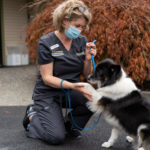I love dogs, especially the oldies. Over the last 8 years, I have had six senior dogs as part of my family. The experiences with these pups continue to teach me that we need to accept the inevitable aging process of our beloved dogs and change our routines and environment to let them live their best lives in their senior years.
The most common change noted in senior dogs is a change in mobility. This may be from previous traumas, repetitive injuries, or simply age-related arthritis. Remember, old dogs don’t get “hip dysplasia”, which is a young dog condition. Though older dogs might get arthritis in the hip joints, more commonly arthritis of the lower back and knees leads to poor mobility in the hind end. We all love our tile and hardwood floors, right? They are easier to clean with pets in the home. I think of these floors like having your 80-year-old parent or grandparent on a skating rink inside the home–a recipe for disaster. Minor slips and falls cause repetitive injury and, just like in older humans, can lead to severe injury. Most senior dogs need to have their exercise routine altered in terms of the distance of walks, the number of walks and toy play. I am an advocate for removing toy chasing games with most senior dogs due to repetitive injury and the potential for severe debilitating injury such as a torn ligament.
- DO: Consider non-slip rugs or carpeting for your senior pet. A cheap 12 ft. non-slip runner rug goes a long way toward your pet feeling safe. It is very important to consider a non-slip rug near the food and water dish that is large enough for your pet to have all four paws on when standing to eat or drink.
- DO: Consider an appropriately raised food and water dish that is easily accessed by your pet. While there are commercially made products to hold a food and water dish, consider something as simple as a Rubbermaid container for a larger dog. I would keep the food in the container for stability and place the food and water dish on top for my old dog, Skagit, a 70 lb lab mix who lived to 14!
- DO: Have traction on stairs or simply don’t expect your pet to climb stairs. If you can safely assist your pet on stairs, do so with a support sling or other safe device.
- DO: Consider ramps for accessing cars, sofas and beds. You may need to train them how to use these with rewards. An unstable ramp is going to be scary for a senior dog and they will likely avoid them.
- DON’T: Allow your senior dog to jump on and off of sofas and beds. While they might be able to it, they are likely causing repetitive injuries to the front legs. If they must be up there, help them up and down. My 15-year-old, Monkey Moo, now sits in her bed on the floor next to the sofa where we can spend time with her with no fear of injury from a fall.
By the age of 11, approximately 30% of all dogs show some type of cognitive decline. Dogs at this age can also start to lose their sense of hearing and sight. This can be seen as staring at walls, getting stuck behind furniture, not being able to find the food or water dish, and abnormal sleep/wake cycles. These behavioral changes are not only affecting our pet’s welfare by increasing fear, stress and anxiety, but can also be very stressful for human caregivers. There are some supplements and medications that may help with cognitive change, though none that will stop this process. Please let your veterinarian know if you see these changes in your dog at their wellness exams. What can you do at home to help?
- DO: Keep a standard routine for waking, feeding, exercise and bedtime.
- DO: Consider their environment at their level, which may only be a foot off of the ground for a small dog. Ensure that they can get to their food and water easily.
- DO: Ensure your dog is eating a well-balanced diet. Diet may need to be altered to ensure your senior pet eats adequate calories and protein. Talk to your veterinarian about options.
- DON’T: Move furniture or block access to typical pathways that your dog may take in your home, don’t move food and water dishes from their standard location
A senior dog still likes to have fun. A change from physical play to mental play has been shown to be quite helpful for the senior dog. Consider some brain exercises as part of your dog’s daily routine.
- DO: Consider games that use your dog’s nose. Puzzle feeders or hiding treats around the home are great ways to keep your senior dog thinking and active. Avoid over feeding by using very small treats or low calorie treats such as pieces of carrot.
- DO: Continue physical stimulation that you dog enjoys, such as leg massage, or face scratching. This can be paired with treats if your dog is generally nervous with touch.
- DO: Play on soft surfaces with traction, such as your dog’s bed or a carpeted room. Hide his toys or play a gentle game of toss. “Find it” games can be quite rewarding for senior dogs that still have a good sense of hearing.
- DO: Consider antioxidant rich food or supplements that can boost your dog’s brain function.
Senior dogs can highly benefit from two veterinary wellness checkups a year to help with early detection of diseases that can occur in older age. In addition, a senior dog rapidly ages and over the course of six months many changes can occur. Discuss noticeable changes in behavior and possible dietary changes with your veterinarian at these visits.


